堀江 栞 HORIE Shiori
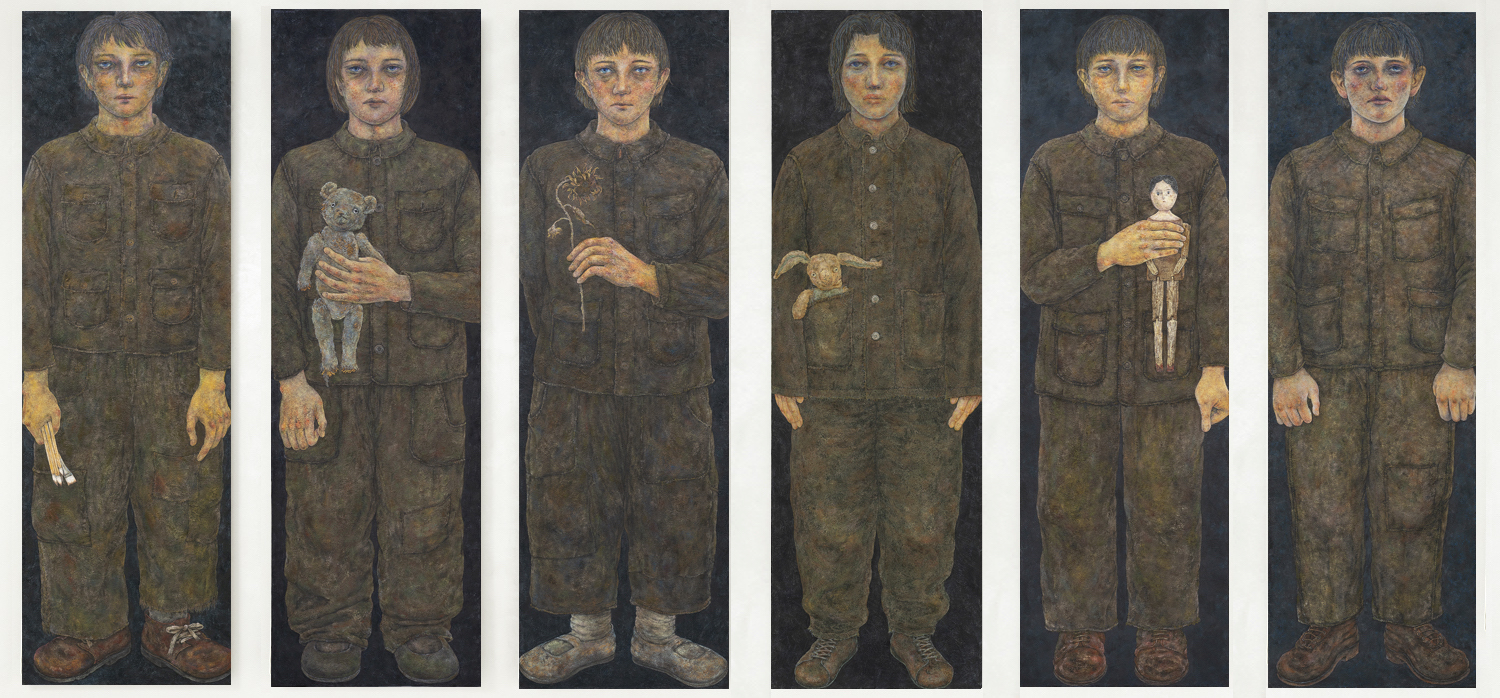
《後ろ手の未来 2023》2021/2023年 和紙、岩絵具、膠 各194×60cm (6点)
Partial Future 2023, 2021/2023, Mineral pigments, Nikawa glue on Japanese paper, 194×60cm each (6 pieces)
堀江 栞
HORIE Shiori
1992年 フランス生まれ。東京都に在住、活動。
「声よりも近い位置」にいるために
堀江 栞
心から好きなものを描き、その芯を確かな形として表したいとの思いで、制作してきました。私には、有機溶剤に対するアレルギーがあります。油絵具やアクリル絵具等の、化学物質が入った画材を使えないため、日本画科に進学し、天然素材由来の岩絵具と顔料、和紙、膠だけで絵を描いてきました。
私にとっては岩絵具の粒子ひとつひとつが、単なる画材ではなく、好きなものを形作る細胞のように思えます。
制作にあたって心がけているのは、モチーフを目の前に置き、距離を縮め、観察を重ねて描いていくことです。対象は、いつもすぐそこに、でも見えないところにあります。長い時間にわたって対話を続けることで彼らに近づき、静かに発せられる声を、なんとか聴き取りたい。2021年4月から6月にかけて行った個展と、この作品集のタイトルを「声よりも近い位置」としたのは、そのような願いをこめてのことです。
描いていくなかで引き寄せられたのは、傷つけられ、痛みを負い、哀しさや辛さを抱えた存在たちです。それがこれまで描いてきた動物や石、人形でした。しかし、2015年の五島記念文化賞によるパリ留学をきっかけに、モチーフとしての「人」と向き合いたいと思うようになりました。
周りに合わせ、意思を表明しないまま流されていきがちな現在の状況に、私は不安を覚えています。歴史を振り返れば、同様の景色が広がっていたことは明らかです。小さな声は蔑ろにされ、異を唱えるものは居場所を奪われてきました。「痛みを負った哀しさや辛さを抱えている者」たちの声。周囲に、社会に踏みつぶされそうな声。そんな声を聴き取るために、「人」を描いてみたいとはじめて思いました。
私が彼らを描こうとしているのは、単なる共感からだけではなく、その抗いの姿勢を継承するためでもあります。今はもういない彼らとこれから来る彼らに、寄り添い続けていきたいと思っています。
『堀江栞 声よりも近い位置』、小学館、2022年、p.2に掲載。
HORIE Shiori
Born in France in 1992. Lives and works in Tokyo, Japan.
Experiencing A Breath Away
HORIE Shiori
Drawn from the heart, my work conveys the essence of the things I love by giving them a definite shape. I have an allergy to organic solvents. Since I can’t use chemical-based paints like oils or acrylics, I pursued the study of traditional Japanese painting, making all my work with naturally derived mineral paints and pigments, washi paper, and nikawa glue.
In my view, the individual particles of these mineral pigments make them more than a material. They have a cellular quality, as if literally fleshing out the subjects of my curiosity.
When I’m working, I make every attempt to showcase a motif by closing distances and layering observations. A subject is both always there in front of you and somewhere out of sight. By spending lots of time in dialogue with my subjects, I do my best to approach them, wanting to hear whatever quiet sounds their voices make. It was out of an attempt to capture this dynamic that I gave the title A Breath Away to my most recent solo exhibition, held from April to June 2021.
As I painted, I continually turned to wounded entities. Things in pain, fraught with sadness and anguish. For a time, I painted animals, rocks, and dolls. But in 2015, while studying in Paris on a Gotoh Memorial Cultural Award, I found myself wanting to focus on the human figure.
I feel distressed by the tendency of modern life to pressure people to conform, prizing deference to the majority while discouraging individual intent. History offers a breadth of vivid examples of this pattern. Time and again, the smaller voices have been stifled, as those who dared to dissent lost their place. These are the voices of those in pain, struggling with their sadness and frustration. The voices of those in the periphery, downtrodden by society. I decided to start painting people, so that I could listen to their voices.
My efforts to depict these figures come from more than just a place of sympathy. The hope is to perpetuate the spirit of their protests. My work is an attempt to keep these people company, those who have come and gone and those still on their way.
Translated by Sam Bett
Shiori Horie A Breath Away, edited by Shogakukan, 2022, p.3
堀江栞《後ろ手の未来2023》 推薦文
小勝禮子
私が堀江栞さんの作品を初めて見たのは、この日経日本画大賞展の第6回展(2015年)の折だった。入選作品は《さまよう》(2010年)という、太古の恐竜のような異形の生き物が、長く首を延ばした姿勢で剥製化されたように、その皮膚とも内臓ともつかない襞の一枚一枚を、外科医のように繊細で丁寧な画家の筆運びによって腑分けしていくような画面であった。
何という絵だったことか!それは会場の他のどの画家の絵とも違う、異空間の空気をまとう絵画であった。批評する者としては軽率な言葉だが、「天才」としか言いようのない才能の出現であったと思う。画家はこの絵を描いた時、まだわずか18歳だった。この頃、堀江は他にもハシビロコウや麒麟、鰐などの動物の皮膚の襞を執拗に描き、その異形の生き物を描出して独特の世界を創り出す力が評価されて、2015年に五島記念美術文化賞新人賞を受賞し、翌年1年、生まれた地でもあるパリ留学に旅立ったという。
しかしその後の堀江栞の絵画の進展について、わたしはまったく知らない。2016年のパリ留学と帰国後の成果を集成した、2021年の個展「後ろ手の未来」(世田谷美術館)と連続しての個展「声よりも近い位置」(space√K Contemporaryほか)も知らずに、見る機会を逃してしまった。その間に画家はそれまで描こうとしても描けなかった人間を描くようになっていた。
そして再会したのが5人の人物立像による《後ろ手の未来》(2021年、VOCA展佳作賞)であった。画集『声よりも近い位置』によれば、堀江が留学中、そして帰国後に描き始められた人物たちの絵画は、痛みを抱えた小さな者たちに声を与えるものだったという。まず《輪郭》と題された上半身の子どもたちのシリーズがあり、その集成のように、肩だけの人も含めて20人の少女たちが記念写真のように4列に並んだ《後ろ手の未来》(2019年)という大作が描かれていた。2021年の《後ろ手の未来》は、この人物たちが一人ずつ独立して全身像で描かれたものだ。全体ではなく、個を描きたい。有名な人ではなく無名の個人の肖像を描きたいという意図があったという。髪は短く刈り込まれ、お仕着せの地味な茶色の上着とズボンをはいた人物たちは、敢えて性別もはっきり描かれてはいない。一人を除いてそれぞれが向日葵の花や破れたぬいぐるみ、古い人形、絵筆など、おそらくは自分の大切なものを手にしてそれに心を支えられながら、暗い背景にしっかりと足を踏ん張ってこちらを凝視している。緊張感で張り詰めた空気が漂う。
おそらく堀江がはじめ人物が描けなかったのは、エッセイで語っているように学校の友人の偏狭で差別的な物言いと拒絶に深く傷ついたからだ。ところが、この《後ろ手の未来》(2021)を制作している時にも、堀江はまた別の深刻な精神的苦痛を大切な絵に関わる現場から受けることになったという。そのため、当初6人の人物を予定していたのが5人を描くのが精いっぱいで、その後もずっと岩絵具で絵を描くことができなくなってしまった。画家として最悪な精神状態の中で、それでも堀江は自分の傷に蓋をするために、毎日少しずつ、丸い頭部だけの小さいドローイングを水彩で描き続けたという。それが、個展「かさぶたは、時おり剥がれる」(2023年)で発表された《かさぶた》のシリーズ110点であった。実際は700点以上も描かれた中から選ばれたものだという。そしてやっと1年半の中断を経て、《後ろ手の未来》の6人目の人物も2023年の秋から着手され、完成された。
《かさぶた》の、目も鼻も口も水彩の滲みで流され判然としない崩れた顔の人間たちは、堀江自身の痛みを背負うとともに、過去から未来までの、世界中の虐げられ、押しつぶされ、声を奪われて来た人間たちにつながる。そうしたドローイングでの心の対話のような制作を経て、世に生み出された6人目の人物を加えた《後ろ手の未来2023》は、当然、差別し、虐げることを止めない世界に対する、堀江の言う「抗いの姿勢」を継承する人物たちの群像である。《かさぶた》の崩れた顔たちが弱さの中に透明な光も湛えているように、6人目の人物の視線は澄み通って晴れやかにも見える。彼女たちは、しっかりと足を踏みしめて、前を向いて世界に立ち向かっているのである。
「第9回 東山魁夷記念 日経日本画大賞展」図録、日本経済新聞社、2024年、p.64に加筆。
HORIE Shiori, Partial Future 2023 (Recommendation Message for the 9th Nikkei Nihonga Award Exhibition)
KOKATSU Reiko
My first encounter with HORIE Shiori’s work was at the sixth show (2015) of this same Nikkei Nihonga Award Exhibition. Her work selected in that show was The Wanderer (2010), which depicted a heteromorphic form that resembled an ancient dinosaur. It appeared to have been taxidermized in a posture with its long neck stretched out. The wrinkles, which could be seen as the skin as well as an internal organ, looked as if each and every one was dissected through delicate, meticulous, surgeon-like strokes of the artist’s brush.
It was such an extraordinary work! Her painting was wrapped in the aura of a different dimension, removed from any of the other painters’ works exhibited in that venue. It might sound rash coming from an art critic, but the only way I could describe the emergence of her ability was that she was a “genius.” HORIE was only eighteen when she created The Wanderer. Around that time, she also persistently painted the wrinkles of other animal skins such as a shoebill, a giraffe and a crocodile. She gained recognition for her ability to generate a unique world through visualizing a heteromorphic life-form. In 2015, she also won the 26th Gotoh Memorial Cultural Award (The Tokyu Foundation), Fine Arts Division. With the grant she received, she went to her birthplace of Paris to study for a year in 2016.
However, I had no knowledge of the development of her paintings after that period. Nor was I aware of the two consecutive solo exhibitions that she held in 2021, which culminated her studies in Paris. Thus, I missed the opportunity to view those exhibitions: Partial Future (Setagaya Art Museum) and A Breath Away (√K Contemporary and other venues). During that period, she began to express human figures, which she was unable to do up until that time.
Her paintings that I reencountered were the Partial Future series (2021, VOCA Honorable Mention Award winner), composed of five human figures standing side by side. According to her art book Shiori Horie, A Breath Away, those human figures, which she portrayed in Paris and then in Japan after her return, were aimed at giving voices to nameless people in distress. She initially created the series Figure, which depicted upper-body portraits of children. As the culmination of this series, she created the large-scale painting Partial Future (2019), which was composed of twenty girls (including several only showing their shoulders) standing in four rows, similar to a commemorative photo. In her 2021 work Partial Future, five figures from that painting were independently portrayed in full-length. She wanted to express them not as a whole but as individuals; that is, her aim was to depict the portraits of nameless individuals, rather than the famed. The genders of those figures, all with cropped haircuts and wearing the same sober-brown livery jackets and pants, were deliberately kept ambiguous. Aside from one figure, they each held an object, such as a sunflower, a torn stuffed animal, an old doll and a paint brush. They held objects dear to them as their own emotional supports, while also gazing fixedly toward the viewers as they stood firm against a dark backdrop. This evoked a strong sense of tension.
As she referred to in her essay* the reason why HORIE was initially unable to express human figures was because she had been deeply damaged by the discriminative remarks of and the rejection from her narrow-minded schoolmates. On top of this, when she was creating Partial Future (2021), she suffered yet another form of serious psychological distress in the field of art, which was pivotal to the creation of her paintings. Thus, although she originally planned to create six human figures, she could only complete five of them. It also hindered her from using mineral pigments for quite some time. Regardless of being in the worst state of mind as a painter, she tried to cover her wounds by continuing to spend a period every day depicting small drawings composed solely of circular faces with watercolors. One hundred and ten drawings from the Scab series were shown at her solo exhibition The Scab Comes Off (2023). Those 110 drawings were actually selected from the total of over 700 that she had created. In the autumn of 2023, after a year and a half of inactivity, she finally embarked on the sixth human figure of Partial Future and completed it in that same year.
In her Scab drawing series, the eyes, noses and mouths of the collapsed faces of people were indistinct due to the bleeding of the watercolors. They shouldered HORIE’s own pain, while also reflecting on the people from the past and of the future throughout the world, who have been/are liable to be tyrannized, oppressed and deprived of their own voices. The production of this drawing series allowed her to have dialogues with her own inner mind, which led her to bring the sixth figure of Partial Future (2023) into the world. The group of six figures in this work undoubtedly inherited what Horie has referred to as the “attitude of resistance” toward the world that has not stopped taking discriminatory and oppressive actions. In the same way that the collapsed faces in the Slab series were pervaded with a transparent sense of light in their fragile states, the gaze of the sixth figure appeared to be perfectly clear and radiant. In conclusion, the figures in this work confront the world as they moved forward with their feet firmly on the ground.
*HORIE Shiori, “The Scab Comes Off,” Gunzo (monthly literary magazine), Kodansha, July 2020.
from the 9th Higashiyama Kaii Memorial Nikkei Nihonga Award, exhibition catalog, The Nikkei, 2024 (p.64 revised)
Translated by NANPEI Taeko
堀江栞についての新しい情報は、作家のウェブサイトやSNSをご覧ください。
Please refer to the following artist’s website and social media pages for new updates.
https://www.shiorihorie.com/
https://www.instagram.com/horieshiori/

《さまよう》 2010年 和紙、岩絵具、膠 91×238cm 個人蔵
The Wanderer, 2010, Mineral pigments, Nikawa glue on Japanese Paper, 91×238cm, private collection
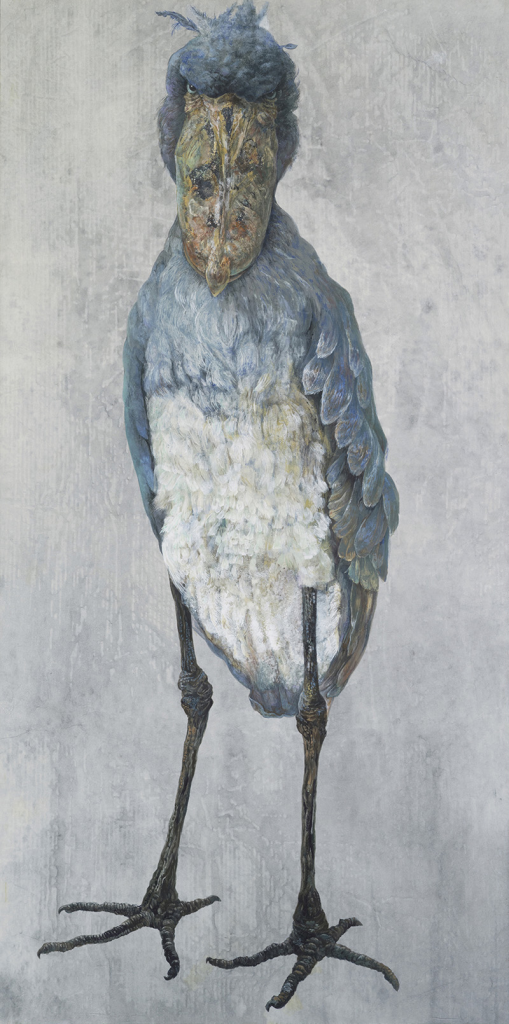
《凜然》2010年 和紙、岩絵具、膠 145.5×72.3 cm
Statuesque, 2010, Mineral pigments, Nikawa glue on Japanese Paper, 145.5×72.3 cm
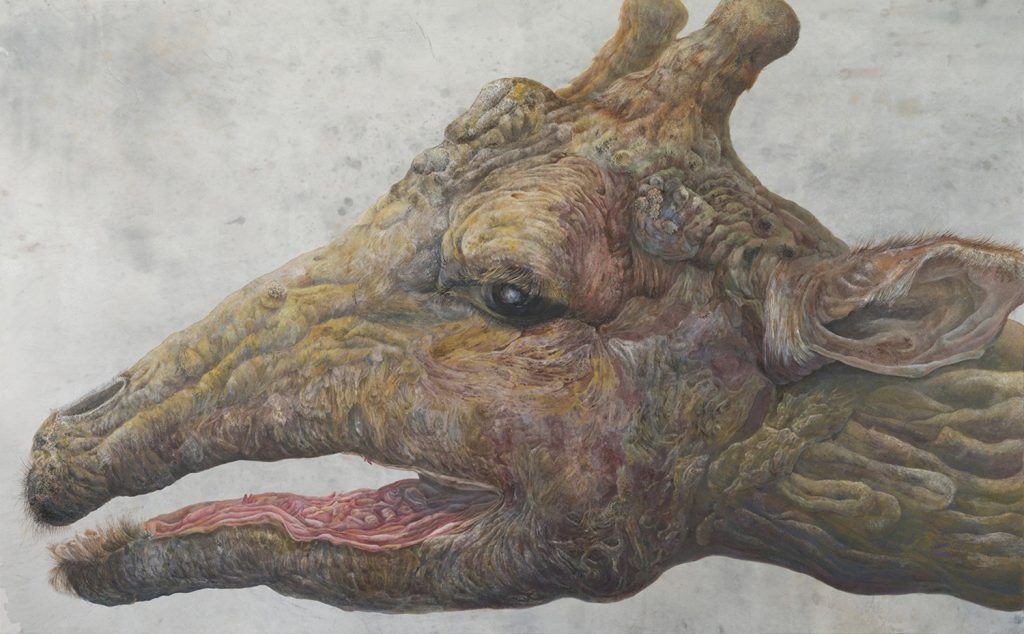
《そっと》2011年 和紙、岩絵具、膠 97×162cm
Lightly, 2011, Mineral pigments, Nikawa glue on Japanese Paper, 97×162cm
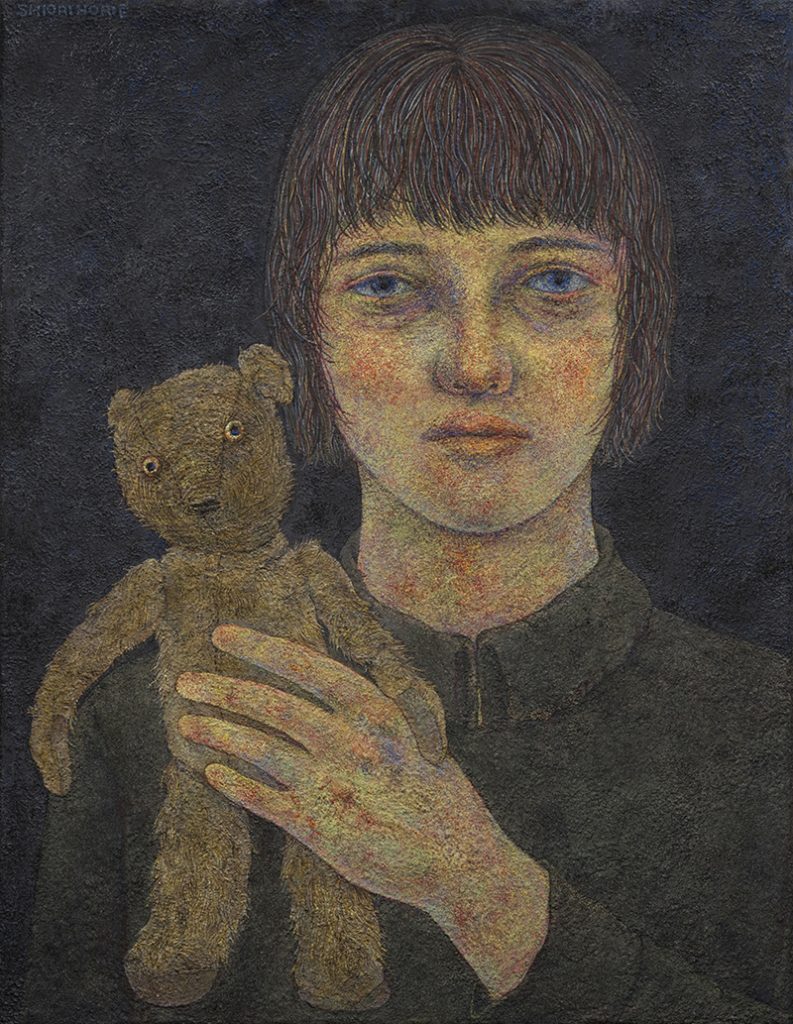
《輪郭#19》2024年 和紙、岩絵具、膠 53×41cm 個人蔵
Figure#19, 2024, Mineral pigments, Nikawa glue on Japanese Paper, 53×41cm, private collection
絵画の撮影:筒口直弘 All Paintings: Photo by TSUTSUGUCHI Naohiro
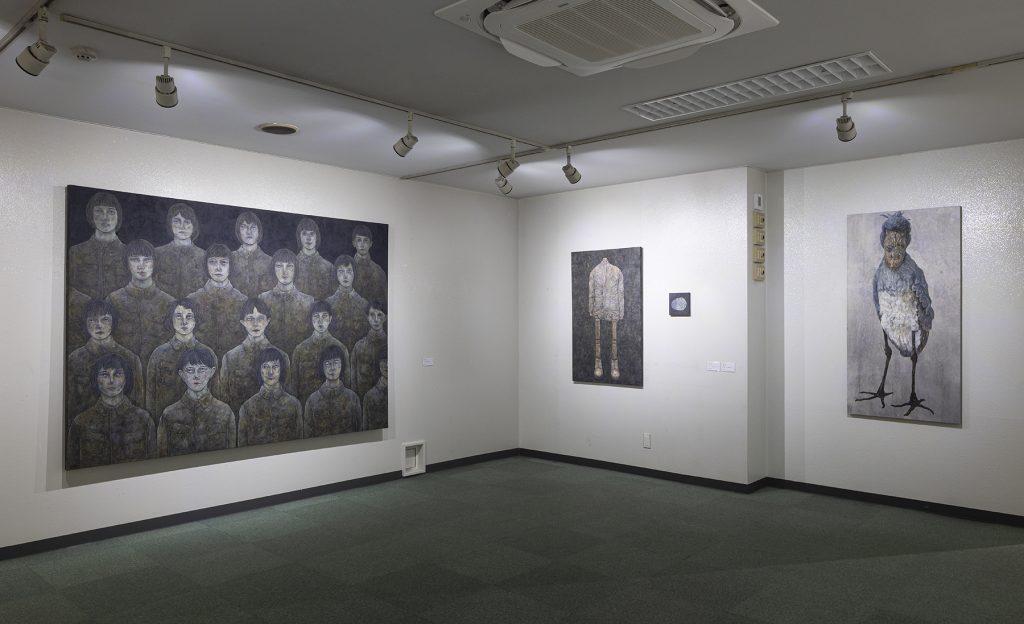
「The 日本・画ー大川美術館のコレクションを中心に」、大川美術館、2024年、展示風景 撮影 木暮伸也
左から、《後ろ手の未来》2019年 和紙、岩絵具、膠 162×227.3cm、《ここに在ることVII》2019年 和紙、岩絵具、膠 116.7×72.7cm、《包まれた時間》より 2017年 和紙、岩絵具、膠 18×18cm、《凜然》2010年 和紙、岩絵具、膠 145.5×72.3cm
Installation View of the exhibition “The Nihon・ga ーFocusing on the Collection of the Okawa Museum of Art”, Okawa Museum of Art, 2024 Photo by KIGURE Shinya
From left: Partial Future, 2019, Mineral pigments, Nikawa glue on Japanese paper, 162×227.3cm, Questions of Being VII, 2019, Mineral pigments, Nikawa glue on Japanese paper, 116.7×72.7cm, from Sealed by Time, 2017, Mineral pigments, Nikawa glue on Japanese paper, 18×18cm, Statuesque, 2010, Mineral pigments, Nikawa glue on Japanese Paper, 145.5×72.3cm

「The 日本・画ー大川美術館のコレクションを中心に」、大川美術館、2024年、展示風景 撮影 木暮伸也
左から、《かさぶた#228》、《かさぶた#367》、《かさぶた♯275》、2023年、紙、水彩、各18×12.5cm、《そっと》2011年 和紙、岩絵具、膠 97×162cm
Installation View of the exhibition “The Nihon・ga ーFocusing on the Collection of the Okawa Museum of Art”, Okawa Museum of Art, 2024 Photo by KIGURE Shinya
from left: Scab #228, Scab #367, Scab #275, 2023, Watercolor on Paper, 18×12.5cm each, Lightly, 2011, Mineral pigments, Nikawa glue on Japanese Paper, 97×162cm

